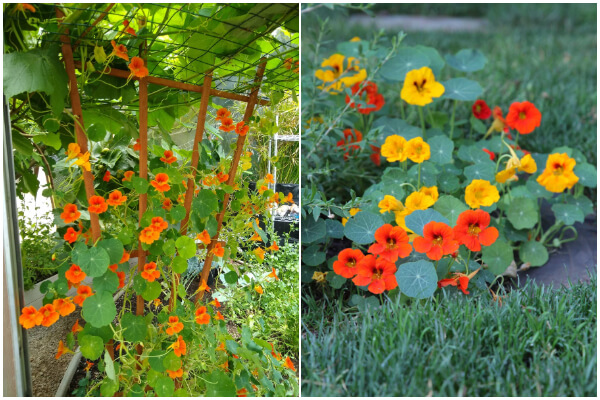Nasturtiums are not just a vibrant addition to your garden; they also offer numerous practical benefits that make them a favorite among gardeners. These versatile plants are easy to grow and serve multiple purposes, from improving garden health to adding flavor to your dishes. Here’s an in-depth look at why you should consider growing nasturtiums in your garden.
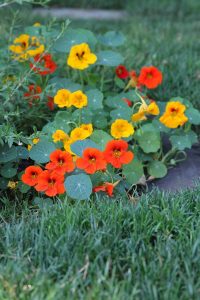
1. Natural Pest Control
One of the standout benefits of nasturtiums is their ability to act as a natural pest deterrent. Known as “trap crops,” nasturtiums attract harmful pests such as aphids, squash bugs, and whiteflies, diverting them from your more valuable plants like tomatoes, cucumbers, and peppers.
Aphids are drawn to nasturtiums, leaving your vegetable plants relatively unharmed. Once pests gather on the nasturtium, they’re easier to manage with organic sprays or natural predators. These edible plants also attract beneficial insects like hoverflies and ladybugs, whose larvae feed on aphids, helping to maintain ecological balance in your garden.
By planting nasturtiums strategically near vulnerable crops, you can reduce the need for chemical pesticides while promoting a healthier, more sustainable garden ecosystem.
2. Edible Flowers and Leaves
Nasturtiums are more than just ornamental plants—they are entirely edible and packed with nutrients. Their peppery flavor adds a unique twist to various dishes. The flowers are not only beautiful but also rich in vitamins B1, B2, B3, and C. They make excellent garnishes for salads, soups, and desserts.
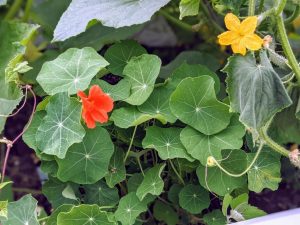
The round, tender leaves are high in vitamin C, iron, and other essential nutrients. They can be used as a substitute for arugula in salads or blended into pesto. Often referred to as “poor man’s capers,” the seed pods can be pickled and used as a tangy condiment. Incorporating nasturtiums into your meals is an easy way to boost your diet with fresh, homegrown produce.
3. Pollinator Magnet
Nasturtiums are a magnet for pollinators like bees, butterflies, and hummingbirds. Their bright, trumpet-shaped flowers are designed to attract these essential creatures. By inviting pollinators into your garden, nasturtiums enhance the pollination of nearby fruits and vegetables, leading to higher yields. With their long blooming season, nasturtiums provide a consistent source of nectar and pollen, supporting pollinator populations throughout the growing season.
Planting nasturtiums alongside crops that require pollination, such as zucchini and squash, can significantly improve your garden’s productivity.
4. Soil Health and Weed Suppression
Nasturtiums are not only good for your plants but also for your soil. They act as a living mulch, covering the ground and providing several benefits.
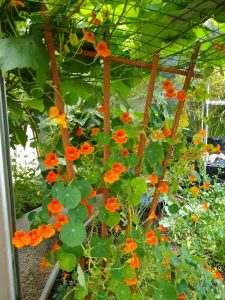
Their dense growth habit shades the soil, preventing weeds from taking root and competing with your crops.Nasturtiums help retain soil moisture by reducing evaporation, which is particularly beneficial during hot, dry weather. As annual plants, nasturtiums naturally break down at the end of their lifecycle, adding organic matter and nutrients back into the soil. By planting nasturtiums, you can improve soil health and reduce the need for additional mulching or chemical weed control.
5. Aesthetic Appeal
Lastly, nasturtiums add undeniable beauty to any garden. Their vibrant flowers come in shades of orange, yellow, red, and cream, creating a stunning visual display.
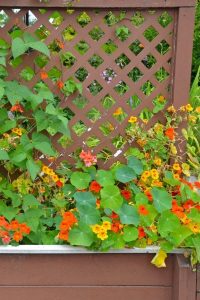
Nasturtiums are incredibly versatile and can be grown as ground cover, in hanging baskets, or trailing over garden beds. These hardy plants thrive in poor soil conditions and require minimal care, making them perfect for gardeners of all skill levels. They make excellent border plants, adding a splash of color while deterring pests from the edges of your garden. Their dual role as functional and decorative plants makes nasturtiums a must-have for any garden enthusiast.
If you’re eager to reap the beauty and benefits of nasturtiums in your garden, follow these easy steps to grow them successfully:
- To begin, sow nasturtium seeds directly into the soil once the danger of frost has passed. These vibrant flowers thrive in a sunny spot, so select a location that receives plenty of sunlight throughout the day. Nasturtiums are relatively low-maintenance, but they do appreciate warm temperatures and lots of light for optimal growth.
- They are known for thriving in poor to moderately fertile soil. In fact, they flourish best in soil that isn’t overly rich in nutrients. For the best results, ensure your soil has good drainage, as nasturtiums don’t like to sit in waterlogged conditions. It’s important to avoid fertilizing the soil too much, as overly rich soil can lead to lush foliage but fewer blooms. By keeping the soil relatively lean, you’ll encourage these flowers to produce more vibrant blossoms.
- These flowering plants are naturally drought-tolerant once they’re established, so they don’t need constant watering. However, during prolonged dry periods, providing regular watering will help them stay healthy and keep the blooms coming. It’s important not to overwater, as this can lead to root rot. A deep watering every few days, particularly during dry spells, is usually sufficient.
Growing nasturtiums in your garden is a simple and rewarding way to enhance its beauty, health, and productivity. From their pest-repelling properties and nutritional value to their pollinator-attracting blooms, these versatile plants offer a wealth of benefits. Whether you’re a seasoned gardener or a beginner, nasturtiums are a low-maintenance addition that can transform your garden into a thriving and visually stunning space. Start planting nasturtiums today and experience the difference they make in your garden!

